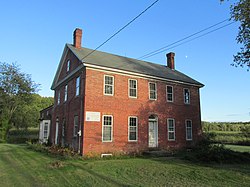Ancien flacon bouteille ouvert pontil verre cisaillé lèvre officiel coventry fonctionne Connecticut CT
Ancien flacon bouteille ouvert pontil verre cisaillé lèvre officiel coventry fonctionne Connecticut CT, Ancien flacon bouteille ouvert pontil verre cisaillé lèvre coventry fonctionne Connecticut CT vente
SKU: 6558252



- Rare
- Antique
- American Glasshouse Made!
- 1830s! (Just shy of 200 years old!)
- Beautiful Olive Green Color
- Pontiled
- Cornucopia Flower Urn
- Pint whiskey flask
- Blown in Coventry, CT!!
- Smooth sheared lip
- 6.5" T
- Ribbed sides
- Bright, Clean, Shiny! No ghosting, no dirt.
- There is a tiny squared-corner on the very bottom of the bottle - not sure if this is how it was manufactured or if someone professionally buffed a chip, either way its in the most obscure location.
- I package well and ship out daily!
Bottle manufacturing in Coventry, Connecticut, was centered around Coventry Glass Works, one of the most well-known early American glasshouses. Here’s what you should know about bottle production in that era and location:
Coventry Glass Works (est. 1813 - 1848)
Located in Coventry, CT, this glass factory was one of several in New England producing hand-blown bottles in the early 19th century.
It operated during the peak of the free-blown and dip-mold bottle-making period.
Manufacturing Techniques
Free-Blown Bottles (pre-1830s)
Many early Coventry bottles were free-blown, meaning they were shaped by hand using a blowpipe and tools rather than being formed in a mold.
These bottles often had asymmetrical shapes and a pontil scar (a rough glass mark on the base where the pontil rod was detached).
Dip Mold & Two-Piece Mold Bottles (late 1820s - 1830s)
By the 1830s, Coventry glassblowers increasingly used dip molds, where the bottle body was formed in a simple mold, but the neck and lip were finished by hand.
Some two-piece molds (with a seam running up the sides) were also in use, but full three-piece molds were still uncommon.
Glass Coloration
Coventry Glass Works was famous for its olive green, amber, and deep blue-green glass, though aqua-colored bottles were also produced.
These hues resulted from the natural iron impurities in the local sand used for glassmaking.
Bottles Produced
Coventry produced flasks, medicine bottles, and spirits bottles.
Some historical flasks from Coventry feature embossed designs, such as eagles, Masonic symbols, and portraits of famous figures (e.g., George Washington).
Identifying an 1830s Coventry Bottle
Hand-blown construction with a rough pontil mark.
Dip mold or free-blown shape, often slightly misshapen.
Applied lip (lip added separately to the bottle’s neck).
Olive green, amber, or deep aqua colors.
No uniform seams like later machine-made bottles.
Historical Significance
Coventry bottles are highly collectible today, particularly the figural and historical flasks.
Bottles from the 1830s are considered early American glass and are sought after by bottle collectors and historians.
Coventry Glass Factory Historic District
Coordinates:41°47′56″N72°21′2″WCoventry Glass Factory Historic DistrictU.S. National Register of Historic PlacesU.S. Historic district House at the corner of US Route 44 and North River Road
House at the corner of US Route 44 and North River Road

Location US 44 and N. River Rd.,Coventry, Connecticut Coordinates 41°47′56″N72°21′2″W Area 32 acres (13ha) Architecturalstyle Federal;Greek Revival NRHPreferenceNo. 87000806[1] Added to NRHP August 27, 1987 TheCoventry Glass Factory Historic Districtis a 32-acre (13ha)historic districtinCoventry, Connecticutthat was listed on theNational Register of Historic Placesin 1987. The listing encompasses ten historically significant houses, clustered near the site of the former Coventry Glass Factory, in a linear district along what was the Boston Turnpike, nowU.S. Route 44. TheSkungamaug Riveris a creek cutting through the district. The glassworks operated here between 1813 and about 1845, and most of these houses date to that time, exhibiting largely vernacularFederalandGreek Revivalstyles. The most sophisticated and best-preserved house is that of Nathaniel Root, at 1044 Boston Turnpike. The ground in the area of the glassworks (of which no structures survive) is littered with melted glass fragments and burnt brick fragments.[2]
The Coventry Glassworks was established in 1813, in part to meet demand for glass objects that had previously been fulfilled by English companies, a source cut off by theWar of 1812. The glassworks founders included experienced glassblowers and local businessmen, who combined their capital and expertise. The company produced small bottles, inkstands, and flasks, and is credited with creating the first "portrait flask", bearing a depiction of theMarquis de Lafayettein commemoration of his 1825 visit to the United States. The company had a rotating cast of partners and glassblowers, and remained in operation until about 1845, when its proprietors at that time moved the business toWillington. Most of the houses in this area were built by or for either the proprietors, or the workers they hired.[2]
See also
[edit]- National Register of Historic Places listings in Tolland County, Connecticut
References
[edit]- ^"National Register Information System".National Register of Historic Places.National Park Service. March 13, 2009.
- ^Jump up to:abBruce Clouette; Matthew Roth; Robert Griffith; John Herzan (October 27, 1986)."NRHP Inventory-Nomination: Coventry Glass Factory Historic District".National Park Service.andAccompanying 16 photos, exterior and interior, from 1986 (see photo map page 17 of text document)



Buy now.
Pay later.
Earn rewards
Representative APR: 29.9% (variable)
Credit subject to status. Terms apply.
Missed payments may affect your credit score








